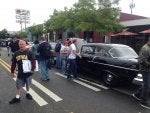Old school here and installing a period correct Muncie 319 circa 1957 transmission w/ overdrive in my 57. The Muncie 319 is a 3 speed standard transmission with overdrive. My 57 has a 3 speed Muncie 318 win it which is a close ratio transmission with out overdrive and 4.56 rear axel gears. It is not a freeway driver as at 70 MPH I'm running close to 4,000 RPM. The car is very stock and this installation is about appearing factory correct so I'm rounding up the correct parts to make a complete working system.
I have the transmission in a shop going through an overhaul and in hand I have a working 12V; solenoid, relay and kick down switch. The 4th component is the governor and I have one but I'm having trouble making it work. The purpose of the governor is to close a set of contacts when the car's speed reaches about 30 MPH. I can spin it with a drill motor and with the cover off I see the weights spinning but during test it does not close the contacts. So I need more details about the internal operation of this governor and I'm wondering if others may have been down this road before. I can vary the speed at which I spin the governor so I believe I'm spinning it fast enough for it to work, I just don't see the contact's closing operation happening. Maybe someone has one of these and make it available to me to buy.
Thanks
Al
I have the transmission in a shop going through an overhaul and in hand I have a working 12V; solenoid, relay and kick down switch. The 4th component is the governor and I have one but I'm having trouble making it work. The purpose of the governor is to close a set of contacts when the car's speed reaches about 30 MPH. I can spin it with a drill motor and with the cover off I see the weights spinning but during test it does not close the contacts. So I need more details about the internal operation of this governor and I'm wondering if others may have been down this road before. I can vary the speed at which I spin the governor so I believe I'm spinning it fast enough for it to work, I just don't see the contact's closing operation happening. Maybe someone has one of these and make it available to me to buy.
Thanks
Al










